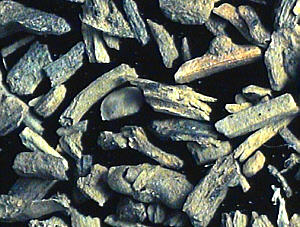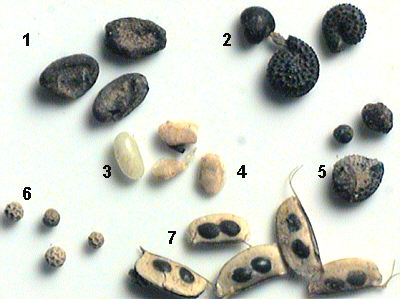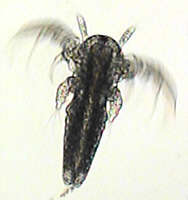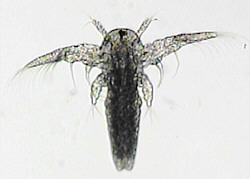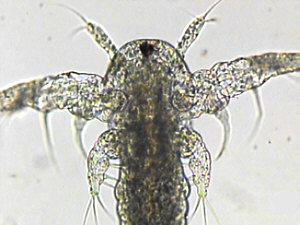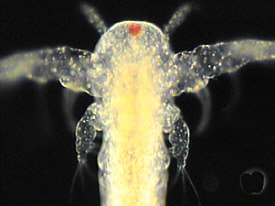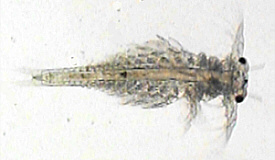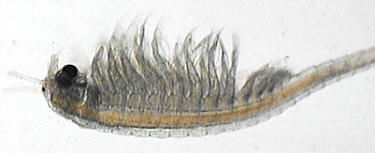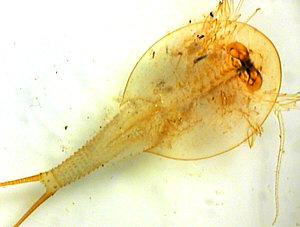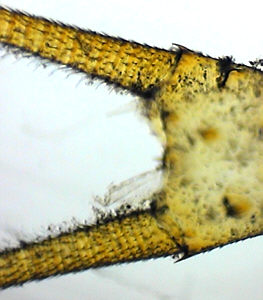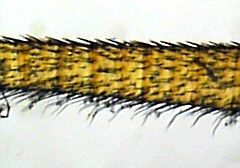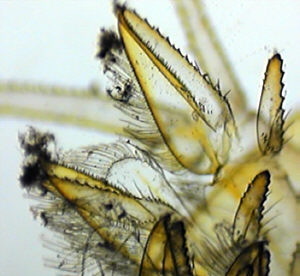The tadpole shrimp and fairy shrimp - two rare British crustaceans ... but available in all good toyshops! by Dave Walker, UK |
Updated July 19th 2000 with new images of the adult Triops.
The author has never seen the tadpole shrimp and fairy shrimp in the wild because they are both rare in Britain. Apparently these crustacean groups and the temporary pools they inhabit, are also increasingly threatened in some other countries e.g. in parts of the USA.
So, if like the author, you're an amateur naturalist living in a country where they are uncommon, is there any opportunity to study these fascinating creatures? Very much so, but you don't need to travel many miles to find the last reported locality (where you may be forbidden to remove and study them anyway); just visit a good local toyshop instead! Rearing the brine shrimp (Artemia) is very popular as an educational kit, but kits to rear the tadpole shrimp (and indirectly the fairy shrimp) are also widely available.
<The crustacea in the Order Anostraca are collectively called fairy shrimps; a group which includes the brine shrimp (Artemia). In this article, fairy shrimp refers just to freshwater species to distinguish it from the brine shrimp>.
The US sourced kits commonly contain Triops longicaudatus and US species of fairy shrimp. But even if these species are not local to you, they offer an opportunity to rear and study examples of these freshwater crustacea. <The sole British species are Triops cancriformis and Chirocephalus diaphanus which are both on the protected species list.> See Appendix note.
The biology and ecology of the tadpole and fairy shrimps are well covered in books and on the Web (see Appendix). As is the related topic of vernal (temporary) pools where these shrimps are indicator species. Because the Triops kits are widely available, these in turn have spawned (excuse the pun) a wealth of Internet resources. One aspect that interests the author, is the wider potential of these type of kits for microscopy and macroscopy, so the author offers a few thoughts on this based on his own early experiences.
What does a typical kit offer?
There are a variety of kits available; the 'Triop World'® kit is shown below. The kit is primarily sold to breed Triops, but the booklet states the egg sachet contains 'detritus' and that there's a strong chance it contains eggs of other vernal pool inhabitants i.e. Triops, fairy shrimp, clam shrimps and water fleas may hatch. Incidentally, clam shrimps (Order Conchostraca) don't occur wild in the UK, so is an extra 'bonus species' for e.g. the British naturalist to rear and study.
You too can 'grow a pet from the era of the dinosaurs'. The tank is shown after three weeks when sand has been added; Triops like to burrow in the sand and may lay eggs in it. One third of the sachet produced two Triops, three fairy shrimp and a selection of water flea species. This kit includes a circular plastic tank (14 cm diameter), two sachets each labelled 'Triops eggs' and 'Triops food' plus a bag of sand. This kit has a particularly clear and well illustrated instruction booklet. |
|
What potential do these kits offer for macroscopy and microscopy?
1) Before adding the
sachet to water ... go egg hunting!
The instructions suggest that half the sachet of 'Triops
eggs' is added to spring/rain water in the tank. But before
carrying out this step, it's worth putting a sample of the
sachet under a stereo microscope or low power of a compound
microscope. The detritus contains interesting fragments of
plant and animal matter (e.g. insect legs), but in particular
the author was interested to see if the eggs of the various
species could be spotted.
The 'Triops eggs' sachet contains a variety of interesting material; the eggs of the species that hatch are in here somewhere. The detritus looks as if it has been processed, e.g. sieved to remove mud etc. (Or perhaps a processed detritus has been 'injected' with a smaller amount of vernal pool deposits?). |
|
If a detritus sample is spread thinly, it's relatively easy to spot and remove potential eggs using the dampened tip of a very fine paint brush. A selection the author found are shown below. The regular pond dipper will have no problem spotting the ephippia (resting eggs) of water fleas. Some other contenders may not be eggs, they could be spores, seeds etc. <The author didn't find many details on what fairy and tadpole shrimp eggs look like. 'Freshwater Aquaria' by G C Bateman, pub. in 1904, states that fairy shrimp eggs although very small can be seen by the naked eye and are "covered very thickly with 'sharp spines'". Possibly number 2 below?>.
| A
selection of material removed from the detritus.
Number 7 are the ephippia of water fleas (possibly
two species) and numbers 3 and 4 look like resting
eggs of some sort. Number 6 could be plant material
although it looks similar to the resting egg of a
clam shrimp (shown in 'Pennak', 3rd edition, p. 14).
The remainder could be of plant or animal origin.
Soak them in water to see what appears! Scale: field of view ca. 6mm. |
|
2) Watch
the eggs hatch?
There's a potential project or two monitoring what
hatches/grows from these egg-like components (if anything).
For example, what happens at the moment of hatching e.g. of a
waterflea? This is a project that could be tackled by the
hobbyist with time lapse video recording. If you have a video
camera, lighting set-up and computer that can be safely left
on for long periods, there's a variety of time lapse software
available e.g. for the Snappy capture card, TV cards and I
believe the Intel Play QX3 video microscope. Shareware time
lapse software is also available.
3) ... and you can
always follow the instructions supplied!
But back to what the kit was intended for. Once the
instructions have been followed, a whole microcosm of a
vernal pool's life develops rapidly before you. In one day,
the nauplius larvae of the shrimp appear as tiny specks,
water fleas also hatch and within six days the water fleas
had given live birth to countless others. So there's plenty
of opportunity to monitor the life forms of interest from the
microscopic to macroscopic. The general behaviour and feeding
habits of the shrimps are also fascinating. (The author did
not notice any clam shrimps hatch in this first rearing
experiment.)
Photographic records, video clips, or sets of drawings can be made. Perhaps permanent mounts of the growing stages. The larger organisms can be identified to species e.g. with 'Pennak'. The author was planning to key out the two to three species of water flea present, as at least one looked like a non-native species to the UK, but in the author's tank the water flea population 'crashed' very quickly. Only a third of the sachet was used, so fresh tanks can be established. (New sachets are also available from the suppliers). The mature shrimps only last a few months, so offer opportunities for dissection and slide mounts of parts when they expire. The shrimps go through a series of moults so the cast-offs may be collected as well if reared e.g. in a Petri dish where the skins may be more easily spotted.
Update: since writing this article, a moult from the 40mm long adult Triops was spotted after four weeks, removed from the tank and preserved. See gallery below for new images.
Some of the author's first attempts to keep a photographic record of live nauplius larvae development are shown below. I found it quite a challenge with the video microscopy equipment possessed (security camera with capture card). The minimum capture time with the Snappy capture box was 1/60th second which isn't short enough for crisp pictures. The immature and mature organisms are very active and photography could benefit from a good electronic flash set-up with film camera and then scanning the results.
N.B. The
growth rate could depend on the tank conditions and feeding
rate. (The Triops food sachet contains plant fragments).
The author's tank was kept at ca. 18-20ºC, i.e. lower than
the recommended 21-27ºC.
|
Trying to capture a good video still! The lefthand still does give a sense of the larvae's vigorous activity. (3.5x objective, no eyepiece). This pair and the next two below are after two days development. Length ca. 0.55mm. |
|
| A
sharper image captured at one of the few periods of
inactivity. (9x objective, no eyepiece). The so-called nauplius larvae of the fairy and tadpole shrimp resemble those of the more familiar copepods e.g. cyclops, except the former commonly exhibit beginnings of the trunk segments. |
|
| Dark-field illumination works well to show the larvae's red eyespot, although depth of field is low with the condenser diaphragm wide open. (9x objective, no eyepiece). |
|
| Immature fairy shrimp after four days, (right and below). These stills don't really capture this creature's delicate and graceful form. |
|
| The author doesn't have a low power darkfield facility but fairy shrimp could look good in this type of illumination. Length ca. 2mm after six days. Adults depending on species can grow up to ca. 35mm. (9x objective, no eyepiece). |
|
| The Triops after 11 days development (ventral view). Chasing one of these around a Petri dish trying to take its piccie is great fun! The adult can grow up to ca. 40mm. |
|
Images of cast-off skin from adult Triops.
| The
image right isn't the live adult Triops, it's a shed
exoskeleton (ventral view) after four weeks
development. These are wonderful subjects for both
the stereo and low to medium powers of the compound
microscope. Almost every external detail of the
shell, limbs, mouthparts, antennae etc from the
living adult are retained. So the cast-offs are a
good opportunity to study these features without
killing Triops specimens. (Body 23mm long, 40mm long
including appendages). With careful dissection there are many features in this single cast-off that would make good permanent mounts. |
|
| Detail of telson, i.e. the last abdomen segment and shows the base of the two cercopods (the 'tails'). Objective 3.5x, no eyepiece. |
|
| Cercopod detail showing the segments and spines. Objective 3.5x, no eyepiece. |
|
| The
mouthparts and limb structure are wonderfully
complex, but the moult needs dissecting to fully
appreciate. The image shows a hint of this complexity
at the head with antenna in background (ventral
view). Objective 3.5x, no eyepiece. (See web link below for a detailed article on the Triops' anatomy). |
|
Summary so far ...
If, like the author, you've never seen a fairy shrimp or tadpole shrimp before, this type of kit can provide hours of enjoyable study with hand lens, compound microscope and stereo microscope. Few freshwater macro-invertebrates match the grace and beauty of a swimming fairy shrimp. The Triops looks like nothing else you will find in a pond; from early development to maturity they are fascinating and the adults rather appealing. The moulted exoskeleton from the adult Triops is one of the most amazing subjects the author has ever seen under a microscope. But as remarked above, although the kits' main purpose is to breed Triops, there's a wide variety of projects both at a fun or deeper level that the enthusiast of macroscopy, microscopy and freshwater life could carry out.
Comments to the author Dave Walker welcomed.
Appendix
Suppliers
Try your local large toyshop, the kits are sold under various names. UK prices are typically £7-£15.
The 'Triop World' kit is available from e.g. Netfysh. I'm not sure whether other Triops kits will also produce fairy shrimp.
The UK 'Index' catalogue offers the 'Prehistoric Sea Monsters' kit (type 420-423 in catalogue no. box).
The Micro Mole on-line catalogue offers a fascinating variety of 'aquatic ecosystem materials' to rear Triops, fairy shrimp, green algae, daphnia, mixed protists etc. They can supply more comprehensive kits with guides for teaching purposes.
The US sourced kits (i.e. most of the above) will probably rear the US species T.longicaudatus. Triops.CC Biological Supply offer kits to rear the European species T.cancriformis and ship worldwide.Please note - the release of non-native species into the wild is usually illegal. Thus the detritus or species grown from them should not be disposed of into the wild, drains etc, or even in your own garden pond where the sediments can be carried further. Even if the species are native, unauthorised distribution is not recommended. (See link below on the tadpole shrimp as a pest).
Books
Larger books on freshwater life or invertebrates should have good sections on these crustacea. e.g. R W Pennak, 'Freshwater Invertebrates of the United States' has an excellent chapter on the Eubranchiopoda (fairy, tadpole and clam shrimps) with many illustrations and keys.A selection of Internet resources
Invertebrate anatomy. Triops longicaudatus - by Richard Fox, Lander University. The author's article on brine shrimp anatomy Artemia salina is here. (Artemia are in the same order as the freshwater fairy shrimp).Tadpole shrimp. University of California Pest Management Guidelines. - tadpole shrimp are a pest to seedling rice stands.
The Vernal Pool Association - a wonderful on-line resource covering many aspects of this increasingly threatened habitat. Includes illustrated overviews of the life cycle and ecology of indicator species e.g the tadpole and fairy shrimp.
Vernal pools - an illustrated summary by Christopher Rascon of vernal pools and their inhabitants. Includes images of how a typical pool changes during a season.
California Vernal Pool Assessment (The Resources Agency, Dept. of Fish and Game) - an extensive on-line illustrated report on the state of these pools in California. Includes lists of species found in such pools.
The Habitats Directive- selection of Special Areas of Conservation in the UK. - the Joint Nature Conservation Committee (UK) web site includes descriptions of the 'Mediterranean temporary ponds' habitat sites still remaining in the UK where both the shrimps live. The New Forest and Lizard peninsula are two of the remaining UK sites. Invertebrates protected under 'The Wildlife and Countryside Act, 1981: Schedule 5' (UK) are listed here.
'Totally Triops' web ring - brings together the web pages of enthusiasts who have also bought and used these kits. Includes links to a range of related resources, hints on rearing and suppliers. (Also see web ring links below).

